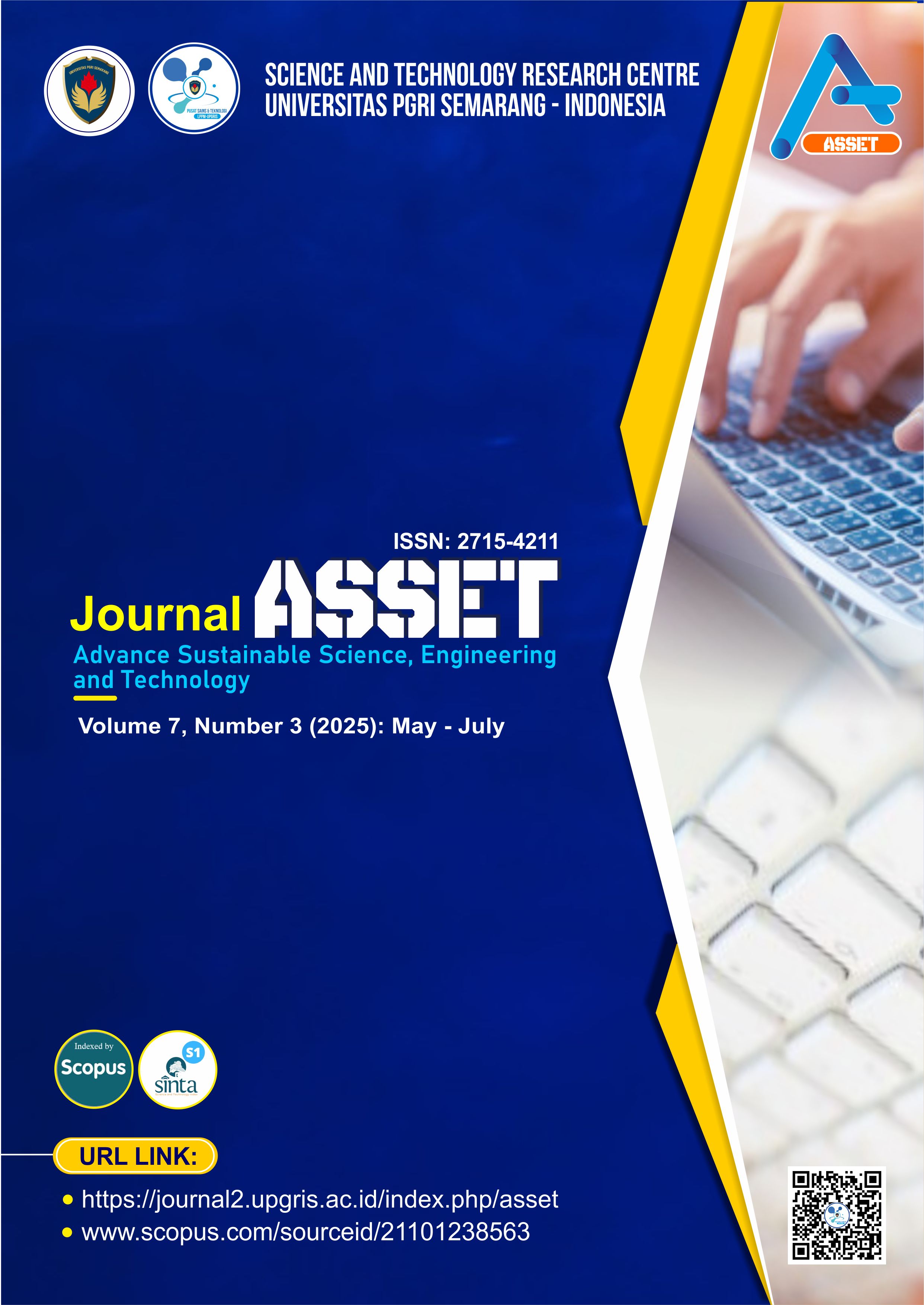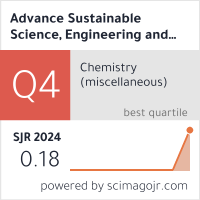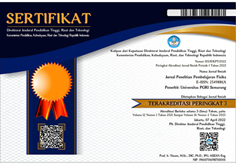Hybrid Expert System for Academic Stress Diagnosis Using Forward Chaining and Score Weighting
DOI:
https://doi.org/10.26877/asset.v7i4.2586Keywords:
cademic stress, diagnosis, expert system, forward chaining, score weightingAbstract
Academic stress classification is a significant challenge in education, as previous approaches often rely on opaque models or require large training datasets. This study develops a hybrid expert system for academic stress classification using forward chaining and Certainty Factor (CF) score fallback. The system was tested on 100 student cases with the following label distributions: Mild (48), Moderate (37), and High (13), classified independently by three experts. Label validity was tested using pairwise Cohen's kappa, yielding a mean value of 0.8280. The system achieved 100% accuracy, a 32% improvement over the classical forward chaining baseline (68%). Statistical evaluation using Wilson score intervals demonstrated high consistency across all key metrics (accuracy, precision, recall, F1-score) with a 95% CI of [96.4%, 100%]. The system is designed with an explicit and auditable rule structure, enabling deterministic classification based on symptoms. Although validation results are high, the unbalanced label distribution opens up the potential for spectrum bias. Going forward, the system is planned to be tested across institutions, assessed for integration with counseling services, and compared with other hybrid approaches.
References
[1] M. Mofatteh, “Risk factors associated with stress, anxiety, and depression among university undergraduate students,” AIMS Public Health, vol. 8, no. 1, pp. 36–65, 2021, https://doi.org/10.3934/publichealth.2021004
[2] M. Huenergarde, “College Students’ Well–Being: Use of Counseling Services,” Am. J. Undergrad. Res., vol. 15, no. 3, Dec. 2018, https://doi.org/10.33697/ajur.2018.023
[3] Z. Xu, “The Impact of Online Resources on Reducing Mental Health Stigma among International College Students: A Case Study,” Lect. Notes Educ. Psychol. Public Media, vol. 58, no. 1, pp. 141–147, July 2024, https://doi.org/10.54254/2753-7048/58/20241770.
[4] A. Karttunen, A. Hakkarainen, and L. Holopainen, “Associations between School Burnout, Perceived Learning Difficulties, and Delayed Graduation from Upper Secondary Education: A Longitudinal Study,” Int. J. Educ. Psychol., vol. 12, no. 3, pp. 289–306, Oct. 2023, https://doi.org/10.17583/ijep.10637.
[5] R. Yusof, N. H. Mohamed Harith, A. Lokman, M. F. Abdul Batau, Z. Mohd Zain, and N. H. Rahmat, “A Study of Perception on Students’ Motivation, Burnout and Reasons for Dropout,” Int. J. Acad. Res. Bus. Soc. Sci., vol. 13, no. 7, p. Pages 403-432, July 2023, http://dx.doi.org/10.6007/IJARBSS/v13-i7/17187.
[6] Ahsanu Bil Husna, Asyifa Salsabila Rahmi, and Nur Ilmya Nugraha Ningrum Irfandi Putri, “Exploring the Root Causes of Burnout Syndrome among College Students: A Systematic Literature Review of Contributing Factors,” J. Promkes, vol. 13, no. SI1, pp. 246–260, Jan. 2025, https://doi.org/10.20473/jpk.V13.ISI1.2025.246-260.
[7] N.B. Mahesh Kumar, T. Chithrakumar, T. Thangarasan, J. Dhanasekar, and P. Logamurthy, “AI-Powered Early Detection and Prevention System for Student Dropout Risk,” Int. J. Comput. Exp. Sci. Eng., vol. 11, no. 1, Jan. 2025, https://doi.org/10.22399/ijcesen.839.
[8] D. B. Olawade, O. Z. Wada, A. Odetayo, A. C. David-Olawade, F. Asaolu, and J. Eberhardt, “Enhancing mental health with Artificial Intelligence: Current trends and future prospects,” J. Med. Surg. Public Health, vol. 3, p. 100099, Aug. 2024, https://doi.org/10.1016/j.glmedi.2024.100099.
[9] O. Ali, W. Abdelbaki, A. Shrestha, E. Elbasi, M. A. A. Alryalat, and Y. K. Dwivedi, “A systematic literature review of artificial intelligence in the healthcare sector: Benefits, challenges, methodologies, and functionalities,” J. Innov. Knowl., vol. 8, no. 1, p. 100333, Jan. 2023, https://doi.org/10.1016/j.jik.2023.100333.
[10] H. Henderi, F. Al Khudhorie, G. Maulani, S. Millah, and V. T. Devana, “A Proposed Model Expert System for Disease Diagnosis in Children to Make Decisions in First Aid,” INTENSIF J. Ilm. Penelit. Dan Penerapan Teknol. Sist. Inf., vol. 6, no. 2, pp. 139–149, Aug. 2022, https://doi.org/10.29407/intensif.v6i2.16912.
[11] S. I. Oguoma, K. K. Uka, C. A. Chukwu, and E. C. Nwaoha, “An Expert System for Diagnosis and Treatment of Mental Ailment,” OALib, vol. 07, no. 04, pp. 1–22, 2020, https://doi.org/10.4236/oalib.1106166.
[12] M. T. Hafizal et al., “Implementation of expert systems in potassium deficiency in cocoa plants using forward chaining method,” Procedia Comput. Sci., vol. 216, pp. 136–143, 2023, https://doi.org/10.1016/j.procs.2022.12.120.
[13] M. D. Sinaga, F. Tambunan, C. J. M. Sianturi, A. Syahputra, F. Tahel, and S. Aliyah, “An Expert System for Diagnosing Leptospirosis Disease Using Forward Chaining and Bayes Theorem,” in 2019 7th International Conference on Cyber and IT Service Management (CITSM), 2019, pp. 1–4. https://doi.org/10.1109/CITSM47753.2019.8965338.
[14] T. Mazhar et al., “A Novel Expert System for the Diagnosis and Treatment of Heart Disease,” Electronics, vol. 11, no. 23, p. 3989, Dec. 2022, https://doi.org/10.3390/electronics11233989.
[15] D. C. Klonoff et al., “Advance Insulin Injection Technique and Education With FITTER Forward Expert Recommendations,” Mayo Clin. Proc., vol. 100, no. 4, pp. 682–699, Apr. 2025, https://doi.org/10.1016/j.mayocp.2025.01.004.
[16] C. Wang, J. Zhang, N. Lassi, and X. Zhang, “Privacy Protection in Using Artificial Intelligence for Healthcare: Chinese Regulation in Comparative Perspective,” Healthcare, vol. 10, no. 10, p. 1878, Sept. 2022, https://doi.org/10.3390/healthcare10101878.
[17] M. Abdelshiheed, J. W. Hostetter, X. Yang, T. Barnes, and M. Chi, “Mixing Backward- with Forward-Chaining for Metacognitive Skill Acquisition and Transfer,” in Artificial Intelligence in Education, M. M. Rodrigo, N. Matsuda, A. I. Cristea, and V. Dimitrova, Eds., Cham: Springer International Publishing, 2022, pp. 546–552, http://dx.doi.org/10.48550/arXiv.2303.12223.
[18] S. Kamley, S. Jaloree, and R. S. Thakur, “Forecasting of Major World Stock Exchanges Using Rule-Based Forward and Backward Chaining Expert Systems,” in Quality, IT and Business Operations: Modeling and Optimization, P. K. Kapur, U. Kumar, and A. K. Verma, Eds., Singapore: Springer Singapore, 2018, pp. 297–306. https://doi.org/10.1007/978-981-10-5577-5_23.
[19] J. Rodríguez-Arce, L. Lara-Flores, O. Portillo-Rodríguez, and R. Martínez-Méndez, “Towards an anxiety and stress recognition system for academic environments based on physiological features,” Comput. Methods Programs Biomed., vol. 190, p. 105408, July 2020, https://doi.org/10.1016/j.cmpb.2020.105408.
[20] M. H. Zolfagharnasab et al., “A novel rule-based expert system for early diagnosis of bipolar and Major Depressive Disorder,” Smart Health, vol. 35, p. 100525, Mar. 2025, https://doi.org/10.1016/j.smhl.2024.100525.
[21] J. Wang et al., “Refined micro-scale geological disaster susceptibility evaluation based on UAV tilt photography data and weighted certainty factor method in Mountainous Area,” Ecotoxicol. Environ. Saf., vol. 189, p. 110005, 2020, doi: https://doi.org/10.1016/j.ecoenv.2019.110005.
[22] H. Soetanto, Painem, and M. K. Suryadewiansyah, “Optimization of Expert System Based on Interpolation, Forward Chaining, and Certainty Factor for Diagnosing Abdominal Colic,” J. Comput. Sci., vol. 20, no. 2, pp. 191–197, Feb. 2024, https://doi.org/10.3844/jcssp.2024.191.197.
[23] A. B. Tofighi, A. Ahmadi, and H. Mosadegh, “A novel case-based reasoning system for explainable lung cancer diagnosis,” Comput. Biol. Med., vol. 185, p. 109547, 2025, doi: https://doi.org/10.1016/j.compbiomed.2024.109547.
[24] J. Rodríguez-Arce, L. Lara-Flores, O. Portillo-Rodríguez, and R. Martínez-Méndez, “Towards an anxiety and stress recognition system for academic environments based on physiological features,” Comput. Methods Programs Biomed., vol. 190, p. 105408, July 2020, https://doi.org/10.1016/j.cmpb.2020.105408.
[25] K. Febrianto, E. D. Udayanti, B. V. Indriyono, W. Mahmud, and I. Zahari, “Expert System for Detection of Diseases in Layers Using Forward Chaining and Certainty Factor Methods,” J. Masy. Inform., vol. 14, no. 2, pp. 80–95, Nov. 2023, https://doi.org/10.14710/jmasif.14.2.52266
[26] I. Azmi, G. Gunawan, and S. Anandianskha, “Application of expert system using certainty factor method to identify diseases in rice plants,” vol. 12, no. 4, 2024, https://doi.org/10.35335/mandiri.v12i4.280.
[27] M. Li, Q. Gao, and T. Yu, “Kappa statistic considerations in evaluating inter-rater reliability between two raters: which, when and context matters.,” BMC Cancer, vol. 23, no. 1, p. 799, Aug. 2023, https://doi.org/10.1186/s12885-023-11325-z.











